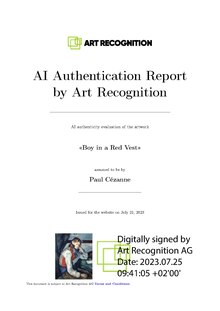A signature is a handwritten depiction of someone's name, nickname, or even a simple "X" or other mark that a person writes on documents as a proof of identity and intent. The writer of a signature is a signatory or signer. Similar to a handwritten signature, a signature work describes the work as readily identifying its creator. A signature may be confused with an autograph, which is chiefly an artistic signature. This can lead to confusion when people have both an autograph and signature and as such some people in the public eye keep their signatures private whilst fully publishing their autograph.

Authentication is the act of proving an assertion, such as the identity of a computer system user. In contrast with identification, the act of indicating a person or thing's identity, authentication is the process of verifying that identity. It might involve validating personal identity documents, verifying the authenticity of a website with a digital certificate, determining the age of an artifact by carbon dating, or ensuring that a product or document is not counterfeit.

Digital art refers to any artistic work or practice that uses digital technology as part of the creative or presentation process. It can also refer to computational art that uses and engages with digital media.
Computer art is art in which computers play a role in the production or display of the artwork. Such art can be an image, sound, animation, video, CD-ROM, DVD-ROM, video game, website, algorithm, performance or gallery installation. Many traditional disciplines are now integrating digital technologies and, as a result, the lines between traditional works of art and new media works created using computers has been blurred. For instance, an artist may combine traditional painting with algorithm art and other digital techniques. As a result, defining computer art by its end product can thus be difficult. Computer art is bound to change over time since changes in technology and software directly affect what is possible.

Art forgery is the creation and sale of works of art which are falsely credited to other, usually more famous artists. Art forgery can be extremely lucrative, but modern dating and analysis techniques have made the identification of forged artwork much simpler.
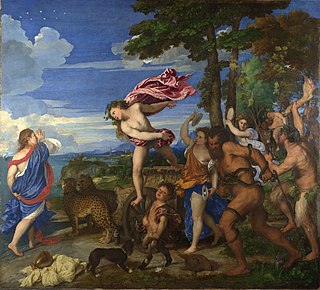
Bacchus and Ariadne (1522–1523) is an oil painting by Titian. It is one of a cycle of paintings on mythological subjects produced for Alfonso I d'Este, Duke of Ferrara, for the Camerino d'Alabastro – a private room in his palazzo in Ferrara decorated with paintings based on classical texts. An advance payment was given to Raphael, who originally held the commission for the subject of a Triumph of Bacchus.
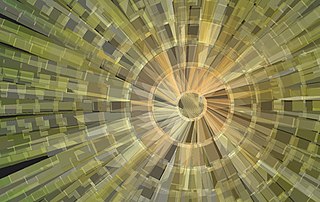
Algorithmic art or algorithm art is art, mostly visual art, in which the design is generated by an algorithm. Algorithmic artists are sometimes called algorists.
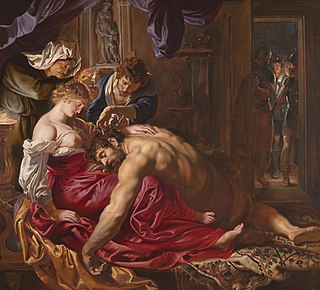
Samson and Delilah is a painting long attributed to the Flemish Baroque artist Peter Paul Rubens (1577–1640) in the National Gallery, London. It dates from about 1609 to 1610.
Anthony Gene Tetro, known as Tony Tetro, is an art forger known for his perfectionism in copies of artwork produced in the 1970s and 1980s. Tetro never received formal art lessons, but learned from books, by painting and experimentation. Over three decades, Tetro forged works by Rembrandt, Joan Miró, Marc Chagall, Salvador Dalí and Norman Rockwell and others. Tetro's paintings and lithographs, known for their perfectionism, were sold by art dealers and auction houses as legitimate works and hang in museums, galleries around the world. He was caught after Hiro Yamagata found a forgery of his own work for sale in a gallery.
Music and artificial intelligence is the development of music software programs which use AI to generate music. As with applications in other fields, AI in music also simulates mental tasks. A prominent feature is the capability of an AI algorithm to learn based on past data, such as in computer accompaniment technology, wherein the AI is capable of listening to a human performer and performing accompaniment. Artificial intelligence also drives interactive composition technology, wherein a computer composes music in response to a live performance. There are other AI applications in music that cover not only music composition, production, and performance but also how music is marketed and consumed. Several music player programs have also been developed to use voice recognition and natural language processing technology for music voice control. Current research includes the application of AI in music composition, performance, theory and digital sound processing.
Hany Farid is an American university professor who specializes in the analysis of digital images and the detection of digitally manipulated images such as deepfakes. Farid served as Dean and Head of School for the UC Berkeley School of Information. In addition to teaching, writing, and conducting research, Farid acts as a consultant for non-profits, government agencies, and news organizations. He is the author of the book Photo Forensics (2016).

Authenticity in art is manifest in the different ways that a work of art, or an artistic performance, can be considered authentic. The initial distinction is between nominal authenticity and expressive authenticity. In the first sense, nominal authenticity is the correct identification of the author of a work of art; of how closely an actor or an actress interprets a role in a stageplay as written by the playwright; of how well a musician's performance of an artistic composition corresponds to the composer's intention; and how closely an objet d’art conforms to the artistic traditions of its genre. In the second sense, expressive authenticity is how much the work of art possesses inherent authority of and about its subject, and how much of the artist's intent is in the work of art.

Lincoln in Dalivision is a 1977 original limited edition lithograph created by Salvador Dalí. It is often considered one of the most counterfeited Dalí lithographs. Dalí authentication experts who have noted the counterfeiting issue with this work include Albert Field, Frank Hunter, Robert Descharnes and Bernard Ewell. Lee Catterall comments in his book The Great Dalí Art Fraud & other deceptions, "The painting most commonly reproduced for such fraudulent purposes was Lincoln in Dalivision, 'prints' of which Los Angeles art appraiser Dena Hall testified in the Hawaii trial have become as commonplace as 'pancakes at the pancake house.'"
Wolfgang Beltracchi is a German art forger and visual artist who has admitted to forging hundreds of paintings in an international art scam netting millions of euros. Beltracchi, together with his wife Helene, sold forgeries of alleged works by famous artists, including Max Ernst, Heinrich Campendonk, Fernand Léger, and Kees van Dongen. Though he was found guilty for forging 14 works of art that sold for a combined $45m (£28.6m), he claims to have faked "about 50" artists. The total estimated profits Beltracchi made from his forgeries surpasses $100m.
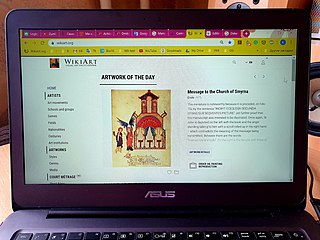
WikiArt is a visual art wiki, active since 2010.
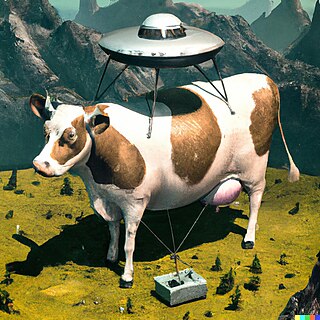
Artificial intelligence art is any visual artwork created through the use of artificial intelligence (AI) programs such as text-to-image models. AI art began to gain popularity in the mid- to late-20th century through the boom of artificial intelligence.

Megvii is a Chinese technology company that designs image recognition and deep-learning software. Based in Beijing, the company develops artificial intelligence (AI) technology for businesses and for the public sector.
Deepfake pornography, or simply fake pornography, is a type of synthetic pornography that is created via altering already-existing pornographic material by applying deepfake technology to the faces of the actors. The use of deepfake porn has sparked controversy because it involves the making and sharing of realistic videos featuring non-consenting individuals, typically female celebrities, and is sometimes used for revenge porn. Efforts are being made to combat these ethical concerns through legislation and technology-based solutions.

DALL·E, DALL·E 2, and DALL·E 3 are text-to-image models developed by OpenAI using deep learning methodologies to generate digital images from natural language descriptions, called "prompts."
Fine art authentication is a process that ensures the integrity of artworks, preserves cultural heritage, and maintains trust in the art market. By combining traditional methods, scientific advancements, and emerging AI and Blockchain technologies, art authentication can offer accurate attributions and protect the artistic legacy for future generations. It consists of proving the authenticity of an artwork and its attribution to a specific artist. This process involves determining the origin, authorship, and historical significance of a piece of art. The proliferation of art forgeries and the increased skill of the forgers who are aware of what scientific analysis reveals requires a rigorous approach to fine art authentication.

